scavenger; feeds on debris in hives or feces in failed larval cells
Sancassania Oudemans, 1916
Superorder Acariformes » Order Sarcoptiformes » Suborder Oribatida » Infraorder Desmonomata » Hyporder Astigmata » Family Acaridae » Genus Sancassania
Sancassania chelone Oudemans, 1916
Caloglyphus Berlese, 1923
In the literature, the genus Ctenocolletacarus is treated as valid. However, its adults are indistinguishable from Sancassania and its phoreticphoretic:
Pertaining to phoresy; using another organism (i.e., a host) for dispersal to new habitats. Phoresy can be distinguished from parasitism because feeding typically does not occur during phoresy.
deutonymphsdeutonymph:
Ontogenetic stage between protonymph and tritonymph (or adult, if tritonymph is absent). See <a href="index.cfm?pageID=1720">Life stages page</a> for more details.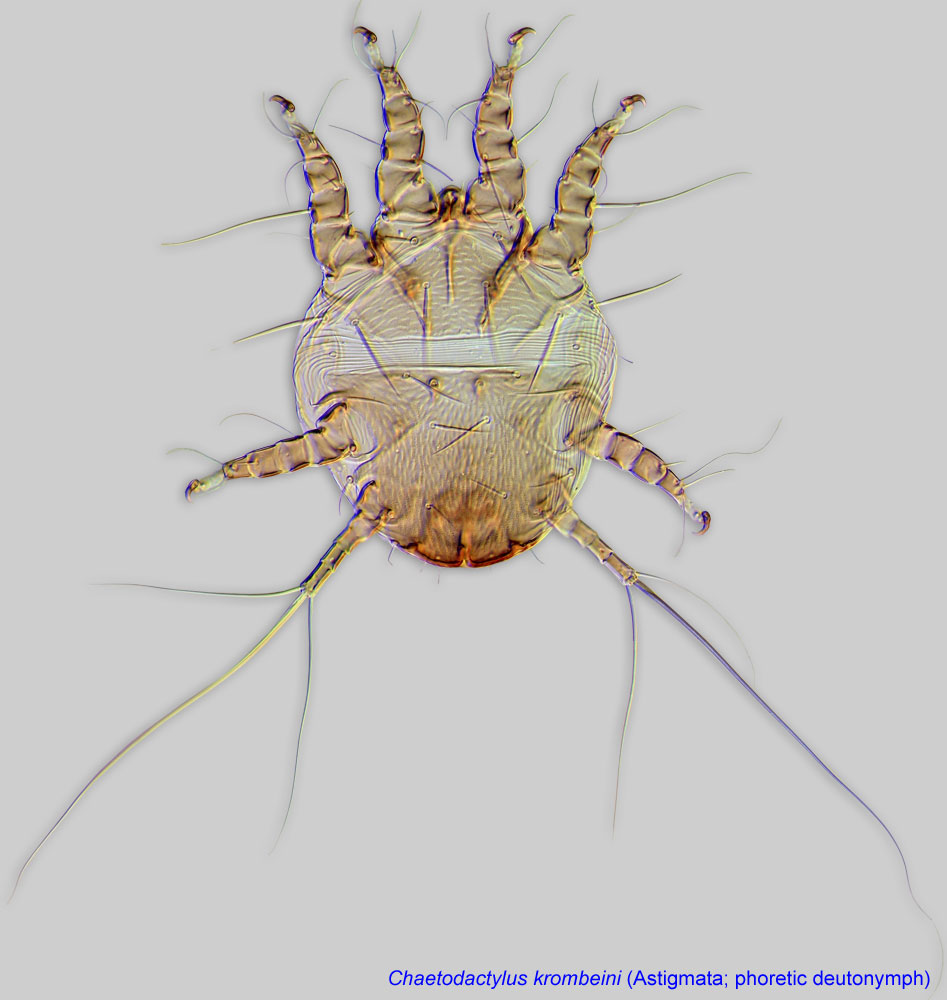 have only autapomorphic (unique, derived) diagnostic character states, suggesting that Ctenocolletacarus is part of Sancassania rather than an independent, genus-level lineage.
have only autapomorphic (unique, derived) diagnostic character states, suggesting that Ctenocolletacarus is part of Sancassania rather than an independent, genus-level lineage.
wet grain mite (for Sancassania berlesei auct. non Michael)
Phoretic phoretic:
Pertaining to phoresy; using another organism (i.e., a host) for dispersal to new habitats. Phoresy can be distinguished from parasitism because feeding typically does not occur during phoresy.
deutonymph: Vertical setae ve present, short (Figs. 3, 4). Tarsal setae aa I present (Fig. 4). Tarsal setae ba I absent, setae ba II present (Fig. 4). Tarsal seta e I-II with saucer-like tip (Fig. 4). GenuaGenu:
Leg or palp segment (also known as podomere or palpomere) between tibia and femur.
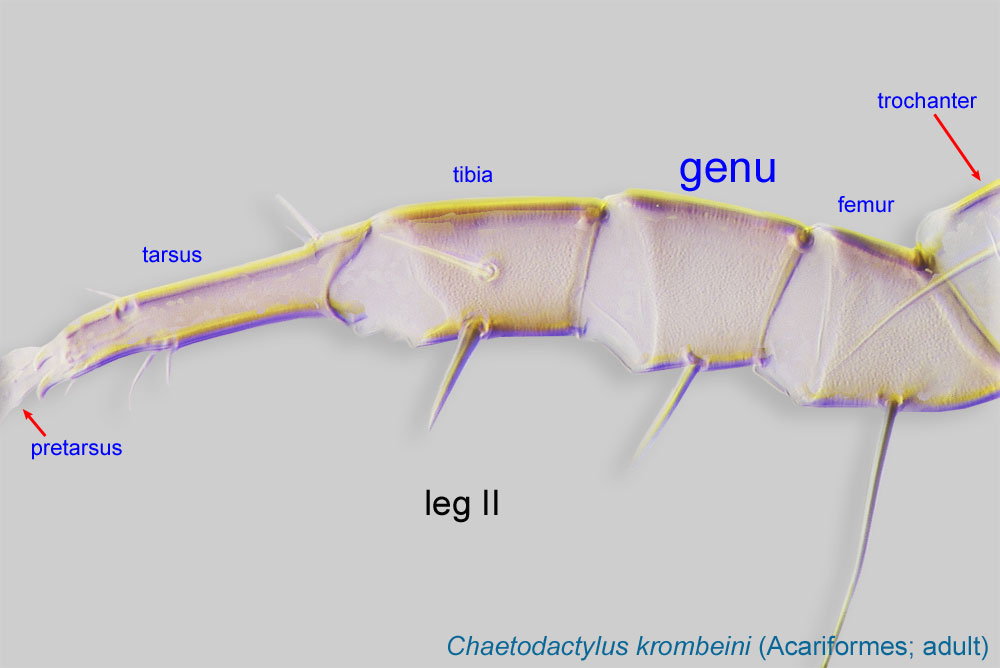 III-IV not distinctly longer than tibiaetibia:
III-IV not distinctly longer than tibiaetibia:
Leg or palp segment (also known as podomere or palpomere) between tarsus and genu.
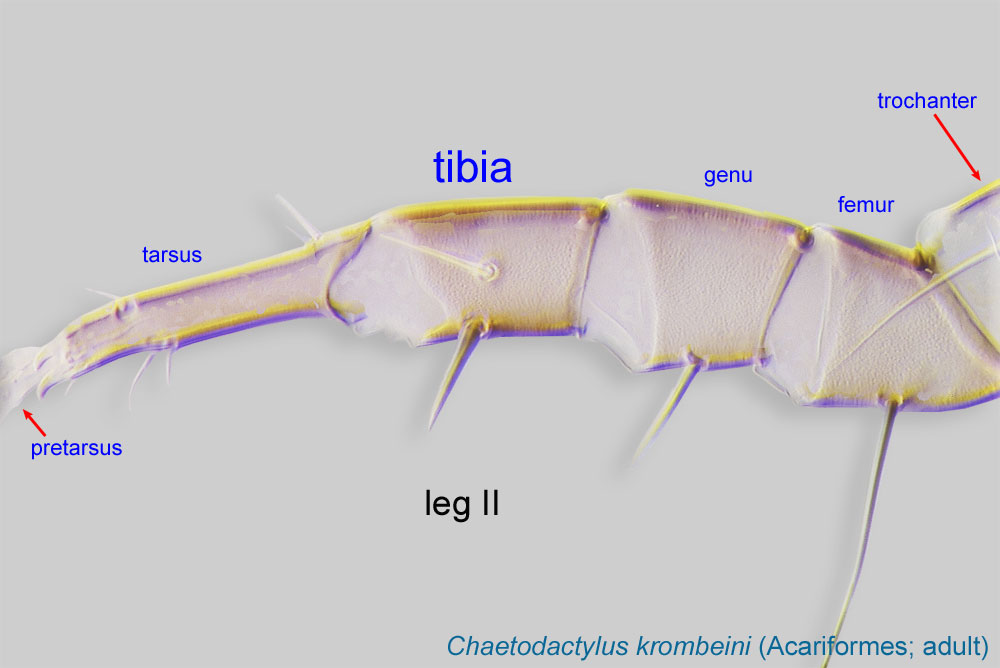 III-IV (Fig. 5). No dorsal solenidionsolenidion:
III-IV (Fig. 5). No dorsal solenidionsolenidion:
Thin-walled, terminally rounded or pointed filiform or peglike structure that is not birefringent in polarized light (unlike common setae in Acariformes). Often appears striated because of its internal structure. Found on the palpal tarsus on the gnathosoma and may also occur on the tarsus and tibia, less frequently on the genu, and occasionally on the femur of legs I-IV. In Acariformes, leg solenidia often arise from unsclerotized areas.
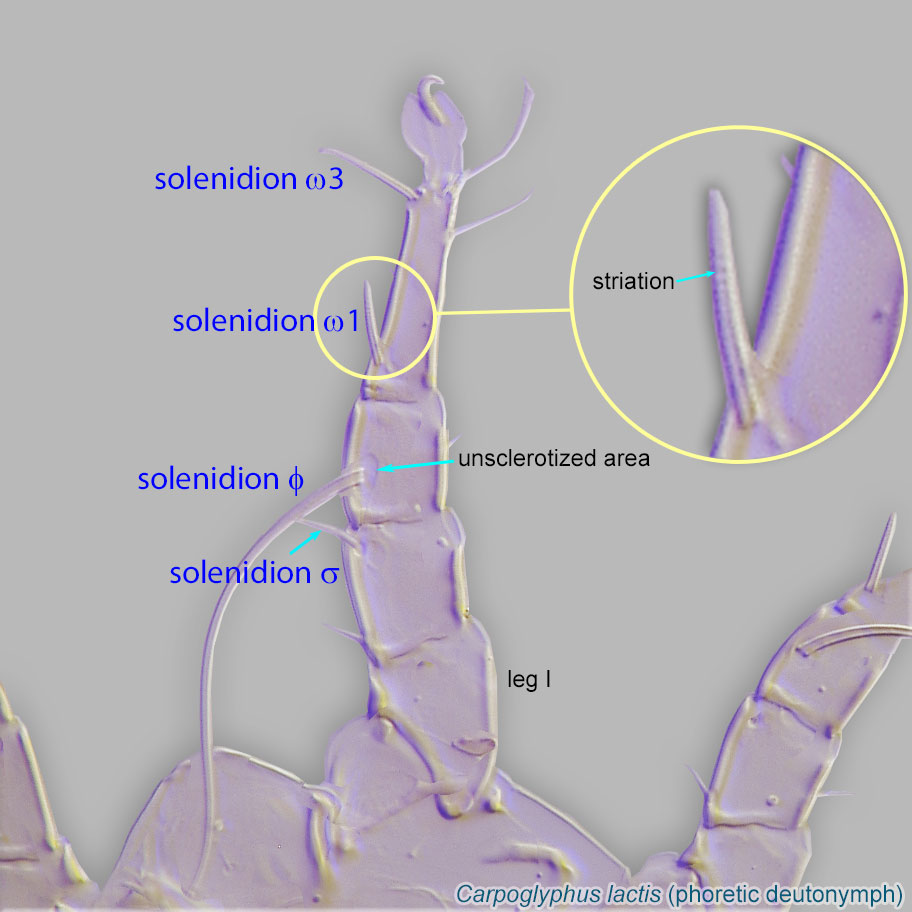 (σ) on genugenu:
(σ) on genugenu:
Leg or palp segment (also known as podomere or palpomere) between tibia and femur.
 III (Fig. 5). Conoidal setae ps2 lateral to median suckers ad1+2 (not anterior) (Fig. 5). No striate membrane posterior to attachment organattachment organ:
III (Fig. 5). Conoidal setae ps2 lateral to median suckers ad1+2 (not anterior) (Fig. 5). No striate membrane posterior to attachment organattachment organ:
Complex unpaired structure in phoretic deutonymphs of Astigmata situated on the posteroventral end of the body that serves for attachment to the host during phoresy. In deutonymphs phoretic on insects, attachment organ consists of a vestigial anal opening and two types of attachment elements: true suckers that create negative pressure and conoids that create adhesive forces. Not to be confused with pedicel.
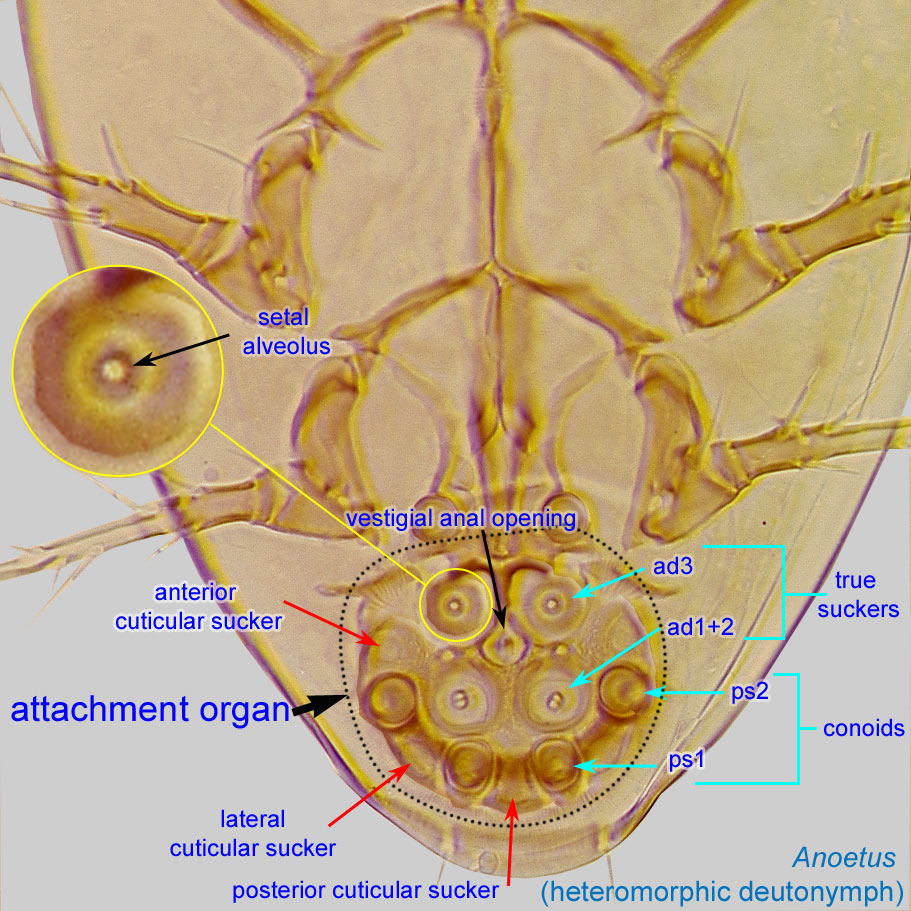 (Fig. 5).
(Fig. 5).
Adult: Setae aa present (correlates with character in deutonymphdeutonymph:
Ontogenetic stage between protonymph and tritonymph (or adult, if tritonymph is absent). See <a href="index.cfm?pageID=1720">Life stages page</a> for more details. ) (Fig. 14). Supracoxal seta filiform (Figs. 12, 13) or short, spiniform; always smooth (never barbed or pectinate) (Figs. 12, 13). Anal opening of female displaced anteriorly, situated in the middle of hysterosomahysterosoma:
) (Fig. 14). Supracoxal seta filiform (Figs. 12, 13) or short, spiniform; always smooth (never barbed or pectinate) (Figs. 12, 13). Anal opening of female displaced anteriorly, situated in the middle of hysterosomahysterosoma:
Division of body posterior to the sejugal furrow, bearing legs III and IV.
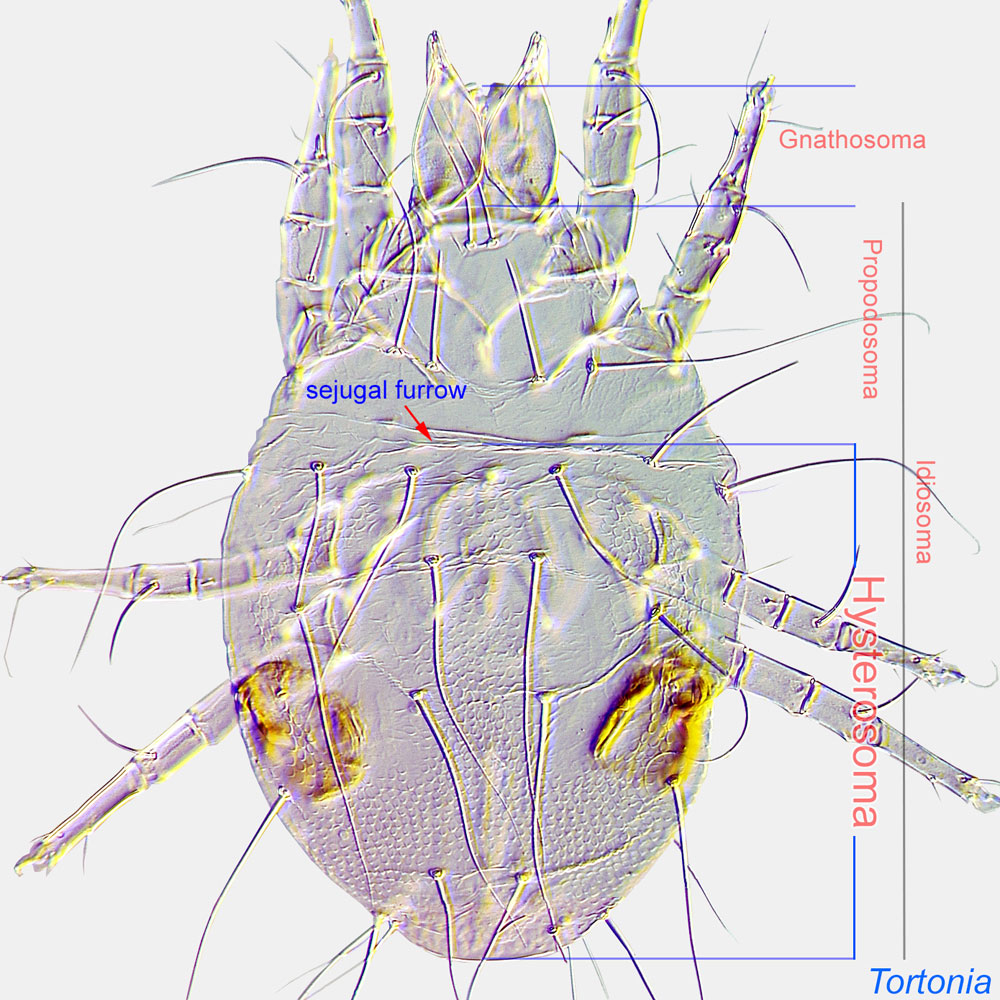 (Fig. 7). Tarsal setae ra and f II with foliate ends (Figs. 13, 14). Setae ra I-II situated near apex of tarsustarsus:
(Fig. 7). Tarsal setae ra and f II with foliate ends (Figs. 13, 14). Setae ra I-II situated near apex of tarsustarsus:
Terminal segment (also known as podomere or palpomere) of legs or palps. In Parasitoformes it can be subdivided into telotarsus and basitarsus.
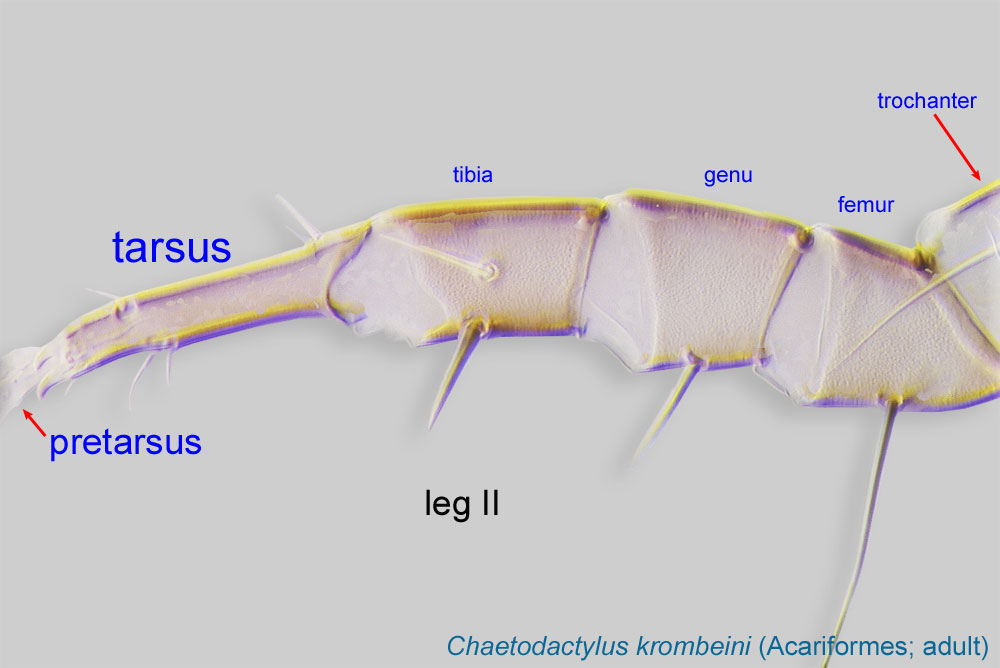 (Figs. 13, 14). Seta e I-II spiniform (Figs. 13, 14).
(Figs. 13, 14). Seta e I-II spiniform (Figs. 13, 14).
Heteromorphic males: Legs III enlarged (Figs. 10, 11); serve as weapons when fighting with other males.
This genus, which has more than 80 species, needs a revision. Common, widespread stored product pests are treated in two older keys to Sancassania species from Middle Europe (Türk and Türk, 1957) and the Palaearctic (Zachvatkin, 1941Zachvatkin, 1941:
Zachvatkin, A. A. 1941. Tiroglifoidnue kleshchi Tyroglyphoidea [=Tyroglyphoid mites Tyroglyphoidea]. In Fauna SSSR: Paukoobraznuye, ed. S. A. Zernov, 475. Moscow-Leningrad: Akademiya Nauk SSSR (translated to English in a separate publication).). Both keys use the name Caloglyphus (currently a junior synonym of Sancassania). Many taxonomic concepts for Sancassania species names, including those included in these two keys (e.g., S. berlesei, S. rodionovi, and S. mycophaga), require revision and careful examination of type material.
Sancassania is similar to Cosmoglyphus in their anterior displacement of the anal opening and morphology of tarsustarsus:
Terminal segment (also known as podomere or palpomere) of legs or palps. In Parasitoformes it can be subdivided into telotarsus and basitarsus.
 I. Phoreticphoretic:
I. Phoreticphoretic:
Pertaining to phoresy; using another organism (i.e., a host) for dispersal to new habitats. Phoresy can be distinguished from parasitism because feeding typically does not occur during phoresy.
deutonymphsdeutonymph:
Ontogenetic stage between protonymph and tritonymph (or adult, if tritonymph is absent). See <a href="index.cfm?pageID=1720">Life stages page</a> for more details. of Sancassania have genuagenu:
of Sancassania have genuagenu:
Leg or palp segment (also known as podomere or palpomere) between tibia and femur.
 III-IV not distinctly longer than tibiaetibia:
III-IV not distinctly longer than tibiaetibia:
Leg or palp segment (also known as podomere or palpomere) between tarsus and genu.
 III-IV (distinctly longer in Cosmoglyphus). Adults of Sancassania have smooth, filiform or spiniform supracoxal setae (lanceolate, with pectinated margins in Cosmoglyphus).
III-IV (distinctly longer in Cosmoglyphus). Adults of Sancassania have smooth, filiform or spiniform supracoxal setae (lanceolate, with pectinated margins in Cosmoglyphus).
Phoretic phoretic:
Pertaining to phoresy; using another organism (i.e., a host) for dispersal to new habitats. Phoresy can be distinguished from parasitism because feeding typically does not occur during phoresy.
deutonymphsdeutonymph:
Ontogenetic stage between protonymph and tritonymph (or adult, if tritonymph is absent). See <a href="index.cfm?pageID=1720">Life stages page</a> for more details. of Sancassania can be distinguished from those of Ctenocolletacarus by the non-enlarged rostrumrostrum:
of Sancassania can be distinguished from those of Ctenocolletacarus by the non-enlarged rostrumrostrum:
In the Oribatida, the anteriormost dorsal portion of the idiosoma; in the Prostigmata (Cheyletoidea), the subcapitulum or the gnathosomal capsule.
(enlarged in Ctenocolletacarus) and the non-striated idiosomaidiosoma:
Body not including the gnathosoma.
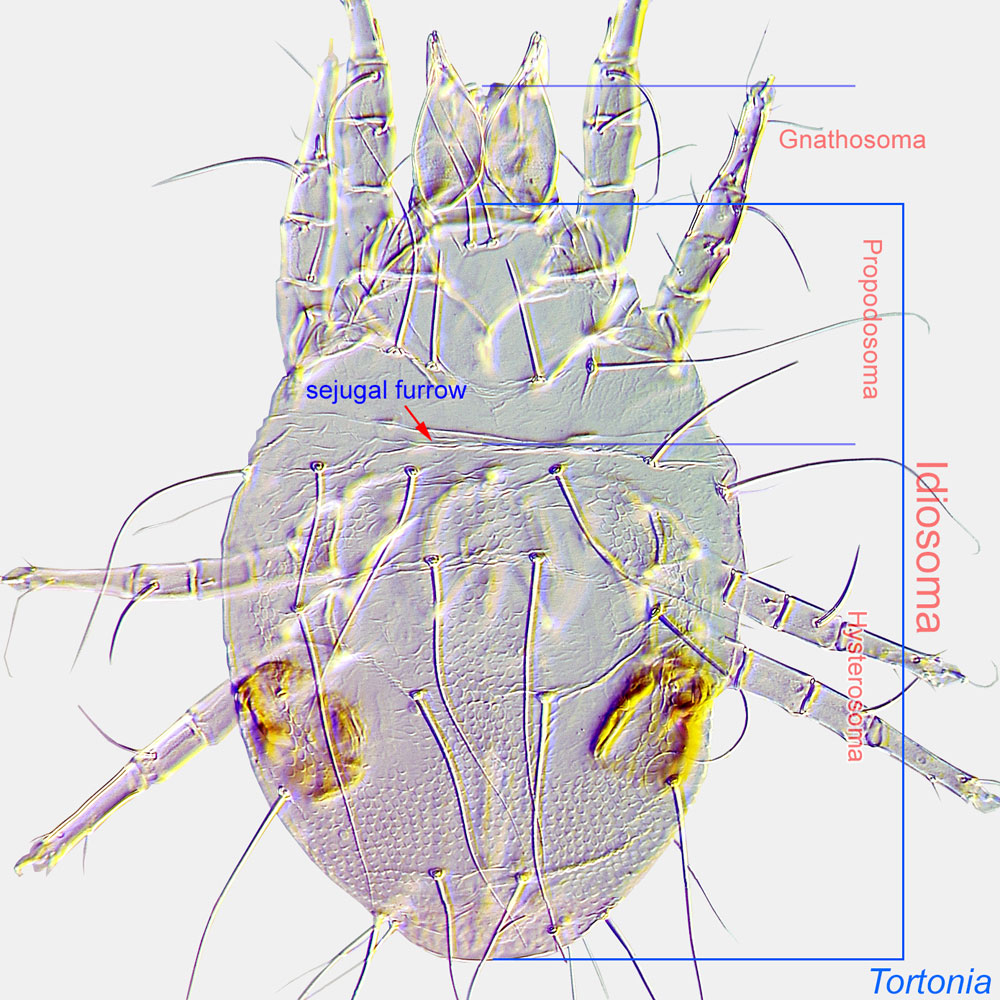 (transversely striated on Ctenocolletacarus). Adanal suckersAdanal sucker:
(transversely striated on Ctenocolletacarus). Adanal suckersAdanal sucker:
Paired pad-like structures situated near the anal opening in males of Astigmata. Originate from adanal setae. Serve for holding female during copulation. Also known as anal suckers and paranal suckers.
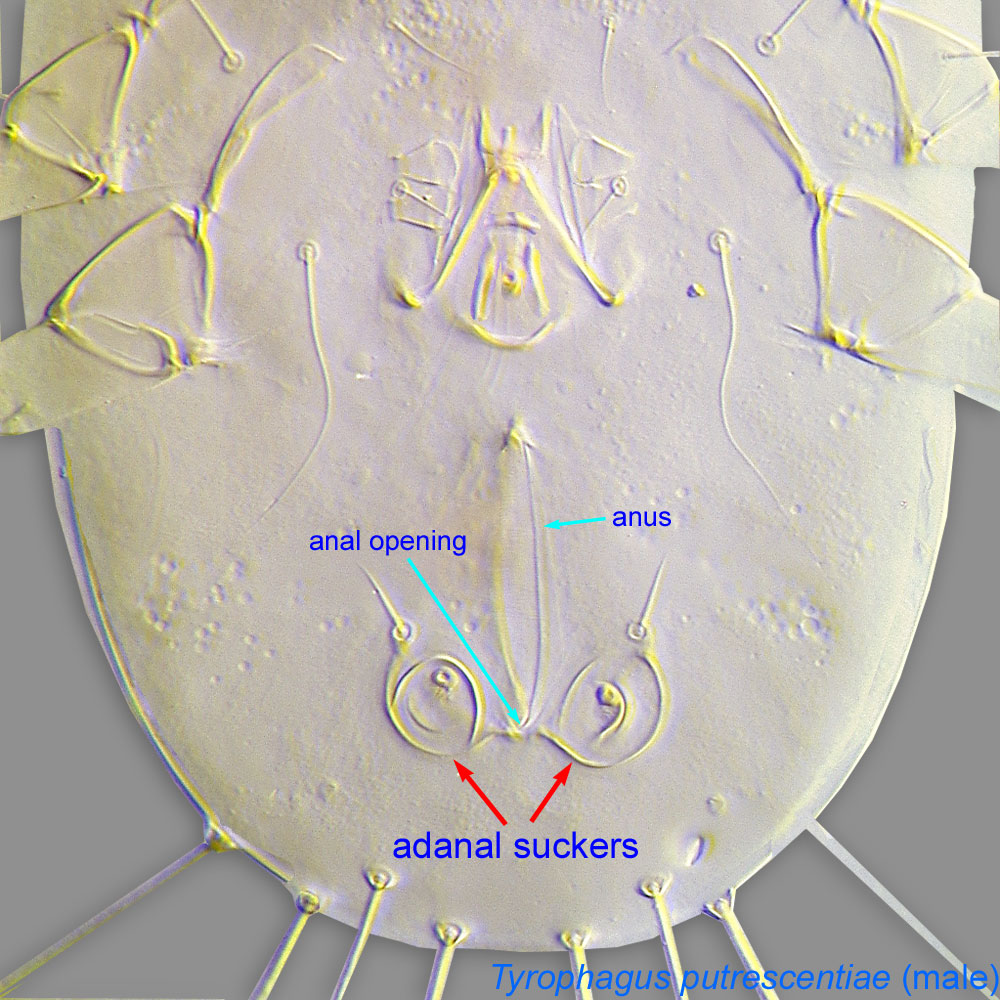 are present in the majority of Sancassania species, while Ctenocolletacarus males lack adanal suckersadanal sucker:
are present in the majority of Sancassania species, while Ctenocolletacarus males lack adanal suckersadanal sucker:
Paired pad-like structures situated near the anal opening in males of Astigmata. Originate from adanal setae. Serve for holding female during copulation. Also known as anal suckers and paranal suckers.
 .
.
The genus is cosmopolitan. Records of mites found on bees or bee nests are from the Nearctic, Palaearctic, Oriental, and Australian regions.
generalists like Sancassania sphaerogaster (= S. mycophaga auct. non Mégnin) and S. rodionovi (=S. berlesei auct. non Michael): Apis mellifera, Apis cerana, Xylocopa flavipes, and Lasioglossum leucozonium
bee specialist Sancassania boharti: alkali bee Nomia melanderi
facultative facultative:
can complete entire life cycle without bees or their close relative, wasps
(most species), permanentpermanent:
associated exclusively with bees or their close relative, wasps; cannot live without these hosts
(Sancassania boharti)
Habitat generalists (e.g., Sancassania rodionovi and S. sphaerogaster)
 opportunistically attach to any insect or arthropod carrier they can find nearby and use it for dispersal to a new habitat.
opportunistically attach to any insect or arthropod carrier they can find nearby and use it for dispersal to a new habitat.Bee specialists (e.g., Sancassania boharti)
 probably infest bee hosts mostly in nest exit tunnels rather than in the brood cells.
probably infest bee hosts mostly in nest exit tunnels rather than in the brood cells. disperse on adult bees, most commonly occurring on male bees (Fig. 15), where they usually attach to the ventral mesosoma. In female bees the mites preferentially attach to the dorsal metasoma. Hence venereal transmission of mites from male to female bee is possible.
disperse on adult bees, most commonly occurring on male bees (Fig. 15), where they usually attach to the ventral mesosoma. In female bees the mites preferentially attach to the dorsal metasoma. Hence venereal transmission of mites from male to female bee is possible.Many species of Sancassania are habitat generalists and are not specialized for a particular phoreticphoretic:
Pertaining to phoresy; using another organism (i.e., a host) for dispersal to new habitats. Phoresy can be distinguished from parasitism because feeding typically does not occur during phoresy.
host. Phoreticphoretic:
Pertaining to phoresy; using another organism (i.e., a host) for dispersal to new habitats. Phoresy can be distinguished from parasitism because feeding typically does not occur during phoresy.
deutonymphsdeutonymph:
Ontogenetic stage between protonymph and tritonymph (or adult, if tritonymph is absent). See <a href="index.cfm?pageID=1720">Life stages page</a> for more details. can be found on a variety of insects, diplopods, and millipedes, but they are most common on scarabaeid beetles.
can be found on a variety of insects, diplopods, and millipedes, but they are most common on scarabaeid beetles.
Habitat generalists feed primarily on wet decomposing organic material and fungi. Some species are agricultural and stored product pests. Unspecialized generalists are known from bee nests, commonly from the European honey bee: Sancassania sphaerogaster (= S. mycophaga auct. non Mégnin) and S. rodionovi (=S. berlesei auct. non Michael) from hives of the European honey bee Apis mellifera. Sancassania rodionovi has also been reported from a nest of the carpenter bee (Xylocopa flavipes). Unidentified species of Sancassania have been sampled from nests of Apis cerana and the halictid bee Lasioglossum leucozonium.
A few lineages are specialists. Sancassania boharti is associated with the alkali bee Nomia melanderi. The presumed subgenus Ctenocolletacarus is associated with ground-nesting stenotritid bees of the genus Ctenocolletes and provides sanitary services to host nests. Many Sancassania species are obligate associates of scarabaeid beetles; they are phoreticphoretic:
Pertaining to phoresy; using another organism (i.e., a host) for dispersal to new habitats. Phoresy can be distinguished from parasitism because feeding typically does not occur during phoresy.
on the beetle as deutonymphsdeutonymph:
Ontogenetic stage between protonymph and tritonymph (or adult, if tritonymph is absent). See <a href="index.cfm?pageID=1720">Life stages page</a> for more details. and feed on the beetle carcass after the host death. Species of the nidicola-species groups specialize in feeding on fruiting bodies of large mushrooms and probably also their mycelium growing underground.
and feed on the beetle carcass after the host death. Species of the nidicola-species groups specialize in feeding on fruiting bodies of large mushrooms and probably also their mycelium growing underground.
A biological account of Sancassania boharti can be found in Cross and Bohart, 1969Cross and Bohart, 1969:
Cross, E. A. amp; G. E. Bohart. 1969. Phoretic behavior of four species of alkali bee mites as influenced by season and host sex. Journal of the Kansas Entomological Society, . 42 : 195-219.. Phoreticphoretic:
Pertaining to phoresy; using another organism (i.e., a host) for dispersal to new habitats. Phoresy can be distinguished from parasitism because feeding typically does not occur during phoresy.
deutonymphsdeutonymph:
Ontogenetic stage between protonymph and tritonymph (or adult, if tritonymph is absent). See <a href="index.cfm?pageID=1720">Life stages page</a> for more details. of Sancassania boharti are usually found on the metasomal integument, crowded into the intersegmental spaces, where they pattern themselves into partially overlapping layers, their orientation opposite to that of the bee, and where they may be hidden from casual observation. Because these mites are found on the metasoma (dorsally in females and ventrally in males), sometimes on structures modified for copulation, this species is most likely to effect venereal transfer.
of Sancassania boharti are usually found on the metasomal integument, crowded into the intersegmental spaces, where they pattern themselves into partially overlapping layers, their orientation opposite to that of the bee, and where they may be hidden from casual observation. Because these mites are found on the metasoma (dorsally in females and ventrally in males), sometimes on structures modified for copulation, this species is most likely to effect venereal transfer.
Additional observations on Sancassania boharti are available from Eickwort, 1979Eickwort, 1979:
Eickwort, G. C. 1979. Mites associated with sweat bees (Halictidae). in (ed.) Recent Advances in Acarology, Vol. 1. ed. J. G. Rodriguez, 575-581. New York: Academic Press. and Eickwort, 1994Eickwort, 1994:
Eickwort, G. C. 1994. Evolution and life-history patterns of mites associated with bees. In Mites: Ecological and Evolutionary Analyses of Life-History Patterns, ed. M. A. Houck, 218-251. New York: Chapman amp; Hall.. In nest cells these mites may occur on feces deposited by bee larvae, but they are especially abundant in cells containing dead bees and moldy provisions. The mites burrow through and tear apart the provision masses, consuming pollen, fungi, and dead brood. There is, however, no evidence that the mites kill the brood; they are presumably scavengers that take special advantage of food resources in cells in which brood fail to develop. DeutonymphsDeutonymph:
Ontogenetic stage between protonymph and tritonymph (or adult, if tritonymph is absent). See <a href="index.cfm?pageID=1720">Life stages page</a> for more details. are facultatively produced and are phoreticphoretic:
are facultatively produced and are phoreticphoretic:
Pertaining to phoresy; using another organism (i.e., a host) for dispersal to new habitats. Phoresy can be distinguished from parasitism because feeding typically does not occur during phoresy.
on bees that develop in other cells; it is probable that these deutonymphsdeutonymph:
Ontogenetic stage between protonymph and tritonymph (or adult, if tritonymph is absent). See <a href="index.cfm?pageID=1720">Life stages page</a> for more details. move through the soil to locate their hosts in the nest burrows.
move through the soil to locate their hosts in the nest burrows.